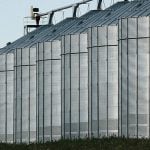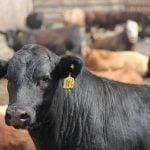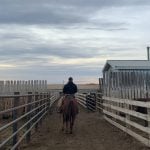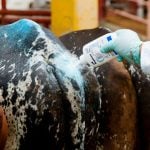
Bovine Respiratory Disease

Mycoplasma bovis in beef cattle causes more than pneumonia
M. bovis causes pneumonia and is a major cause of infectious arthritis in calves and feeder cattle
M. bovis causes pneumonia and is a major cause of infectious arthritis in calves and feeder cattle

Pen riders still better than tech at detecting respiratory disease in feedlot cattle, says researcher
Recent research found that pen riders are better than tech at flagging signs of BRD in feedlot cattle
Recent research found that pen riders are better than tech at flagging signs of BRD in feedlot cattle

Serotonin may be key to solving pneumonia puzzle in cattle
Data regarding serotonin with the human form of the disease could pave the way for research into AIP in cattle
Pen riders move through the feedlot corrals on horseback, watching the cattle with a sharp eye. They are looking for illness, weaving through the herd day after day. They hear the animal with atypical interstitial pneumonia (AIP) before they see it. There’s a rattle in the heifer’s breathing and loud grunting. When they locate the […] Read more

Stress, biosecurity and bovine respiratory disease
Bovine respiratory disease isn’t going away, but there are things ranchers and farmers can do to reduce disease prevalence
Shipping fever. Bovine respiratory disease (BRD). Whatever name you give it, it remains the number one cause of death in feedlots. It pops up on cow-calf operations, too. The Beef Cattle Research Council’s website notes that BRD is a leading cause of death, illness and antibiotic treatment in calves from three weeks of age to […] Read more

AUDIO: Preventing BRD on cow-calf operations
Shipping fever. Bovine respiratory disease (BRD). Whatever moniker you favour, the fact is that it remains one of the most costly health problems in beef cattle today. And although we often think of it as an issue in feedlots, cow-calf operations can also struggle with it, especially if their herds are exposed to other cattle. […] Read more

Keeping calves healthy
Research on the Record with Reynold Bergen
Cow-calf margins get tighter each time you feed a pregnant cow through the winter, only to have her calf die before weaning. Three leading causes of pre-weaning death loss are diarrhea, navel ill and bovine respiratory disease (BRD). Not all calf illness and death can be prevented, especially when the weather gets bad, but remembering […] Read more

Vet Advice: Fatal pneumonia in adult cows
Shipping fever caused by Mannheimia haemolytica is the most important respiratory disease of cattle in North America, particularly in feedlot animals that have been through the stressful marketing and assembly processes (Pathological Basis of Veterinary Disease). M. haemolytica biotype A, serotype 1 is the etiologic agent most commonly responsible for severe pulmonary lesions. Some investigators […] Read more

Dust a risk factor in calf pneumonia
Vet Advice with Dr. Ron Clarke
When drought and the Great Depression introduced the 1930s, the wheat market collapsed. Oceans of wheat had replaced the sea of prairie grass that anchored the topsoil into place. Once the wheat dried up, the land was defenseless against the winds that buffeted the Plains. The term “dust pneumonia” originated during the Great Depression when […] Read more

Everything old is new again – treating chronic mycoplasma
Research on the Record with Reynold Bergen
Cattle were ideally created (or evolved) to consume and digest high fibre diets. Whoever (or whatever) was responsible for designing the rumen so elegantly probably should have paid more attention to the respiratory tract. The design of the bovine respiratory tract makes it easy for BRD bacteria such as Mannheimia, Pasteurella, Histophilus and Mycoplasma to […] Read more

Dealing with diphtheria in calves
Animal Health: The condition is serious enough that swelling can restrict breathing to the point of suffocation
Diphtheria is an upper respiratory problem in cattle characterized by an infection or inflammation of the vocal folds. It can be serious if swelling restricts the airway and makes breathing difficult. Dr. Steve Hendrick of Coaldale Veterinary Clinic at Coaldale, Alta., sees quite a few cases of diphtheria in cow-calf operations and in feedlots. “It’s […] Read more



